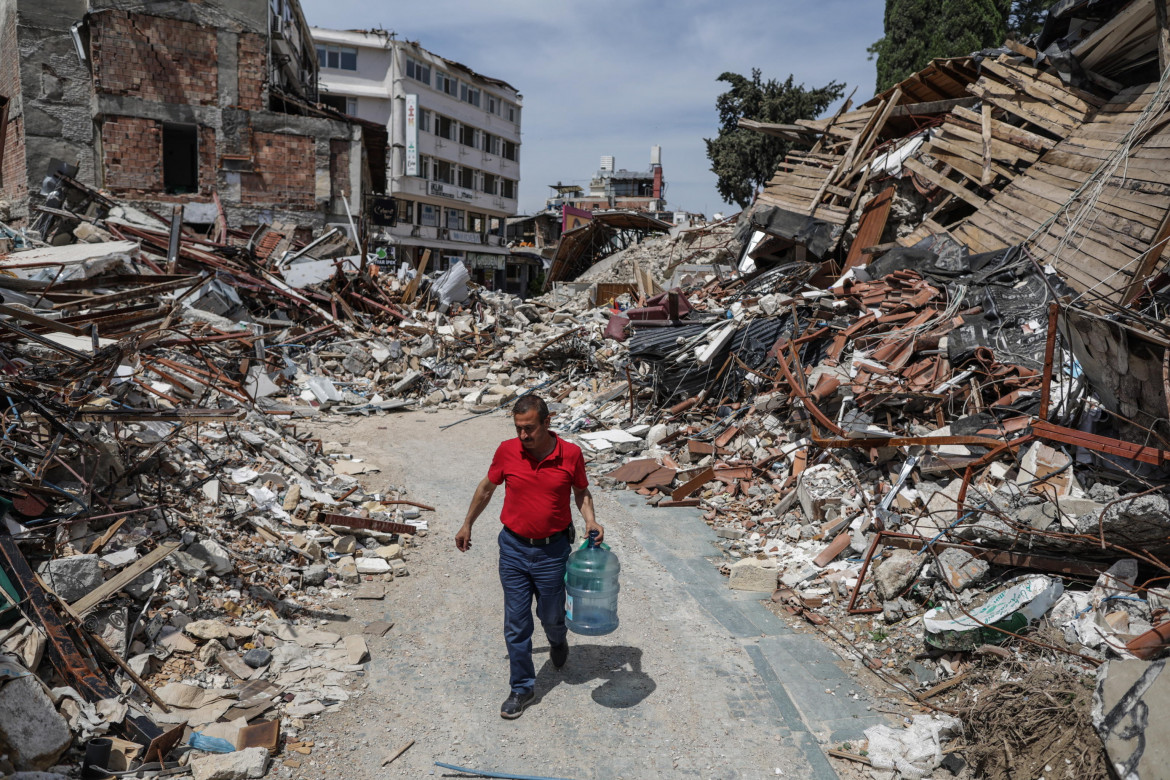Reportage
A capital of toxic rubble
Three months after the earthquake, there are 210 million tons of debris to be disposed of. ‘the train of capitalism in Turkey is riding on rubble and in a state of emergency.'

A mountain of rubble tens of meters high looms over some olive groves just outside Antioch. At times, an endless line of overloaded trucks without covers blocks regular traffic, raising a dust cloud that makes visibility difficult. No one among the workers, police and army forces on the storage site is wearing masks or other protective equipment.
After an hour of visiting this area, one’s clothes and shoes become covered with fine grayish dust, one’s eyes are burning, and one begins to cough and develop a headache. In Hatay province alone, in southern Turkey, there are at least 20 of these large storage sites, and it is possible to see several smaller ones if you drive along some of the roads connecting the main cities.
As a result of the earthquakes that struck a large area on the Turkey-Syria border on February 6 and 20, according to government data, more than 227,000 buildings collapsed or were irreversibly damaged. According to the United Nations, between collapses and demolitions, locations will have to be found for between 116 and 210 million tons of debris, more than 10 times that produced by the 1999 Izmit earthquake near Istanbul.
In the run-up to the elections, which will be held on May 14, and after there have been a number of voices of protest in the first weeks after the earthquake about the delay in relief efforts, the government wants to project an image of speed and efficiency by cleaning up cities and opening construction sites for new housing complexes. Speed is favored even when health is at stake.
Dr. Ali Kanatlı, of the Turkish Medical Association, explains that pending systematic surveys, we can assume the strong presence of asbestos and other hazardous substances in the rubble: “Asbestos was banned 10 years ago in Turkey, but most of the buildings that collapsed or are being demolished were built in the years before. We think lead, used in wall paints, is also present, along with countless other toxic substances contained in destroyed appliances, cars and electronics.”
“On January 25, 2013,” Kanatlı continues, “a law was enacted in Turkey to prevent workers’ exposure to asbestos dust and to protect them from health risks, as well as to determine limit values and other special measures. The removal, transportation and disposal of rubble must be carried out according to this and other relevant laws. Irrigation and dust extraction machines must be used, trucks must be covered, and the ground on which dumping is allowed to occur must be away from water sources and insulated. In addition, the measurement of toxic substances in the air should be carried out continuously, and if the values are higher than allowed, the work must be stopped.”
In the city of Samandag, the haphazard storage of debris and the associated health and environmental risks have begun to cause concern among residents, especially after a landfill was set up next to a tent city where dozens of families of earthquake survivors live. Starting in late March, citizens’ groups, environmental and solidarity associations began organizing weekly demonstrations and community meetings to raise awareness of this.
Levent Büyükbozkırlı, a mechanical engineer and activist with the Climate Justice Coalition, listed the goals of the protest movements: “Operations that do not comply with the laws should be stopped immediately; sites for debris storage should be chosen according to the opinion of a committee of experts in the fields of environment and urban planning; and the separation, treatment and securing of hazardous materials should be carried out according to international protocols approved by the scientific community. In the aftermath of the 1995 Kobe earthquake in Japan and in other cases, we have seen that these operations can take years. Why is there such a rush here?”
The vice-minister of the Environment, Urbanization and Climate Change, Professor Mehmet Emin Birpınar, in a series of posts on Twitter, said that all required measures are being complied with and that no traces of asbestos have been found in the air. However, a whole series of associations have highlighted the lack of effective enforcement. On these grounds, lawyer Ecevit Alkan of the Professional Bar Association, together with other professional chambers, associations and NGOs, filed a lawsuit with the Hatay Administrative Court for an immediate halt to the work of demolishing the buildings and transporting and storing the rubble.
“In normal times,” Alkan says, “everything that is happening here during these weeks would be considered illegal. Although the local authorities, who are in charge of proposing storage sites, are not exempt from responsibility, at the root of this violation of the rule of law is the declaration by a government decree of a state of emergency for three months in the earthquake-affected area. In this way, all decision-making powers have been left in the hands of the prefect. But you cannot under any circumstances use a decree to go against the right to life and health of the people who survived the earthquake. That is why we will win our battle.”
According to historian Aslı Odman, a professor at Istanbul’s Mimar Sinan University, right now “the train of capitalism in Turkey is riding on rubble and in a state of emergency.” For the past two decades, President Erdogan’s AKP (Justice and Development Party) government built its support by mixing neoliberal policies favoring the private sector with a populist discourse, promoting the construction and large-scale building sectors as the main drivers of the economy.
Even now that one of the most devastating earthquakes in the country’s history has the unsustainability of its previous model, the same development model is being pushed once again, taking advantage of the disaster to open a new construction site with rapid demolition and unfettered reconstruction.
Originally published at https://ilmanifesto.it/un-capitale-di-macerie-tossiche on 2023-05-10
